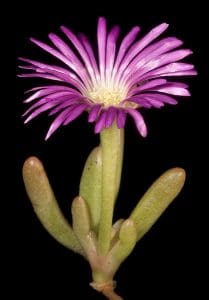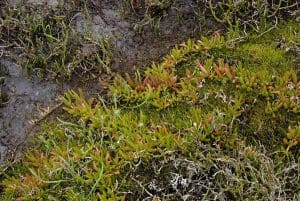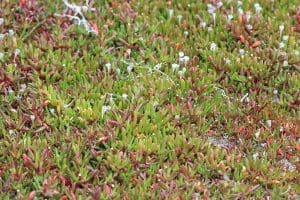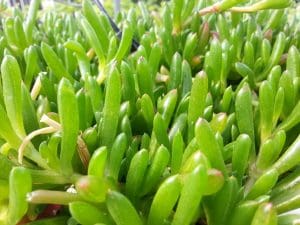Salty Fingers / All Year / Edible
Salty Fingers are an absolutely outstanding species that grows at certain special coastal spots throughout the UK and the rest of the world. This one looks prehistoric and like it shouldn’t be eaten, however it has a delightful salty flavour and the way I best describe it is:
Imagine a grape went for a very long swim in the sea, tired itself out and came back to rest on the shore – and that’s it. A super salty crunchy grape 🙂
Other Common Names:
Pigface, Karkalla, Beach banana, Purple dew plant, Rounded noon-flower
Latin Name:
Disphyma crassifolium
Physical Characteristics:
A creeping succulent plant with finger shaped leaves and daisy-like flowers rimmed in bright purple. The leaves are arranged in opposite pairs that tend to look more like clusters because new leaves grow from the leaf node.
The stems are round and hairless and tend to be found creeping horizontally along the ground.



Top: a beautiful flower that earns this plant the common name Purple Dew Flower. Middle: This plant can grow in very exposed, nutrient poor places like cliffsides. Bottom: you may find an entire carpet of salty fingers, particularly down in Cornwall or on other warm coasts.
Habitat, Range and Distribution:
This is a coastal, salt tolerant plant that can establish on rocks, walls, and disturbed ground very easily. It is found in Australia, New Zealand, South America and southern Asia, and has become naturalised across temperate coasts due to trade. In the UK it tends to be distributed along the warmer coasts and is particularly prevalent in Cornwall and Devon.
Conservation Considerations:
It is an offence to plant or otherwise cause this species to grow in the wild because it can form dense mats in a similar manner to Hottentot Fig. So pick considerately, and be careful not to spread the seeds or break the rhizomes so that they can multiply below the soil.
Harvest Time and Techniques:
Get to know this plant by taste throughout the year. When it flowers (March – July), the leaves can turn red and may become more bitter than you like.
When they’re green, the taste is quite simply a salty pop.
Could Be Confused With, and Other Safety Notes:
It could be confused with Hottentot fig, but the leaf cross section of that plant are very triangular and much more bitter to taste.
Edible Uses:
The intense burst of saltiness given by popping one of these in your mouth is a welcome addition to a range of cooked and raw dishes, particularly alongside other seafood.
Some people say that freezing them to use as ice cubes in botanical gins makes a very aesthetically pleasing presentation. Because of the pleasing leaf arrangement around the stem, it makes a lovely, flavourful garnish.
Medicinal Uses:
None explicitly mentioned, but assuredly a good source of minerals and salts.
Sources:
https://www.plantlife.org.uk/uk/discover-wild-plants-nature/plant-fungi-species/purple-dewplant
https://wildflowerfinder.org.uk/Flowers/D/Dewplant(Purple)/Dewplant(Purple).htm
http://www.seasonalwildflowers.com/purple-dewplant.html







Leave a Reply
You must be logged in to post a comment.